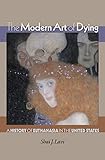The Modern Art of Dying : A History of Euthanasia in the United States / Shai J. Lavi.
Material type: TextPublisher: Princeton, NJ : Princeton University Press, [2009]Copyright date: ©2005Edition: Course BookDescription: 1 online resource (240 p.) : 2 tablesContent type:
TextPublisher: Princeton, NJ : Princeton University Press, [2009]Copyright date: ©2005Edition: Course BookDescription: 1 online resource (240 p.) : 2 tablesContent type: - 9780691133904
- 9781400826773
- 179.7
- R726 .L3797 2005
- online - DeGruyter
- Issued also in print.
| Item type | Current library | Call number | URL | Status | Notes | Barcode | |
|---|---|---|---|---|---|---|---|
 eBook
eBook
|
Biblioteca "Angelicum" Pont. Univ. S.Tommaso d'Aquino Nuvola online | online - DeGruyter (Browse shelf(Opens below)) | Online access | Not for loan (Accesso limitato) | Accesso per gli utenti autorizzati / Access for authorized users | (dgr)9781400826773 |
Frontmatter -- Contents -- Acknowledgments -- INTRODUCTION. The Ethics of the Deathbed: Euthanasia from Art to Technique -- CHAPTER ONE. The Holy Craft of Dying: The Birth of the Modern Art of Dying -- CHAPTER Two. Medical Euthanasia: From Aiding the Dying to Hastening Death -- CHAPTER THREE. Legalizing Euthanasia: The Role of Law and the Rule of Technique -- CHAPTER FOUR. Euthanasia as Public Policy: The Euthanasia Society of America -- CHAPTER FIVE. Lethal Dosing: Technique beyond the Law -- CHAPTER SIX. Mercy Killing: The Limits of Technique -- EPILOGUE. Art and Technique, Death and Freedom -- APPENDIX. Mercy Killing: Case History -- Notes -- Bibliography -- Index
restricted access online access with authorization star
http://purl.org/coar/access_right/c_16ec
How we die reveals much about how we live. In this provocative book, Shai Lavi traces the history of euthanasia in the United States to show how changing attitudes toward death reflect new and troubling ways of experiencing pain, hope, and freedom. Lavi begins with the historical meaning of euthanasia as signifying an "easeful death." Over time, he shows, the term came to mean a death blessed by the grace of God, and later, medical hastening of death. Lavi illustrates these changes with compelling accounts of changes at the deathbed. He takes us from early nineteenth-century deathbeds governed by religion through the medicalization of death with the physician presiding over the deathbed, to the legalization of physician-assisted suicide. Unlike previous books, which have focused on law and technique as explanations for the rise of euthanasia, this book asks why law and technique have come to play such a central role in the way we die. What is at stake in the modern way of dying is not human progress, but rather a fundamental change in the way we experience life in the face of death, Lavi argues. In attempting to gain control over death, he maintains, we may unintentionally have ceded control to policy makers and bio-scientific enterprises.
Issued also in print.
Mode of access: Internet via World Wide Web.
In English.
Description based on online resource; title from PDF title page (publisher's Web site, viewed 30. Aug 2021)


